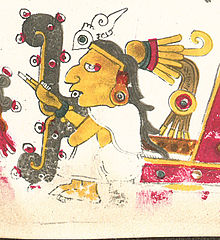Tēcciztēcatl: Difference between revisions
m Picture added. |
Budelberger (talk | contribs) m Nahuatl name. |
||
| Line 2: | Line 2: | ||
[[File:Tecciztecatl.jpg|thumb|A drawing of Tecciztecatl, one of the deities described in the [[Codex Borgia]]]] |
[[File:Tecciztecatl.jpg|thumb|A drawing of Tecciztecatl, one of the deities described in the [[Codex Borgia]]]] |
||
In [[Aztec mythology]], '''Tecciztecatl'''{{ |
In [[Aztec mythology]], '''Tecciztecatl''' (({{lang-nci-IPA|Tēucciztēcatl|teːkʷ.sis.ˈteː.kat͡ɬ}}, "Old Moon god"; also '''Tecuciztecal''', '''Tecuciztecatl''') was a [[lunar deity]], representing the old "[[Man in the Moon|man-in-the-moon]]". |
||
The Aztecs believed that they were living in a universe dominated by a [[Five Suns|generation of sun gods]], the current one known as Tonatiuh, was the fifth. The first three previous suns perished by water, tigers and fiery rain. The fourth was wiped out by a wind storm when people turned into monkeys and spread through the hills. After the fourth sun perished, the Aztecs believed that the gods assembled to decide which god was to become the next sun. They built a bonfire to sacrifice the next volunteer. Two gods – Nanauatl and Tecciztecatl – vied for the honor. Nanauatl, a poor god, was chosen because he could be spared. Proud Tecciztecatl insisted on the honor, but at the last moment hesitated. Nanauatl showed more courage and jumped into the fire. Tecciztecatl gained his courage and followed Nanauatl, thus forming two suns in the sky. The gods, being somewhat class conscious, were angry that rich and proud Tecciztecatl had to follow humble Nanauatl, threw a rabbit at Tecciztecatl leaving an [[Moon rabbit|imprint of the rabbit’s shape]] and dimming Tecciztecatl’s brightness to the point where he could only be seen at night. |
The Aztecs believed that they were living in a universe dominated by a [[Five Suns|generation of sun gods]], the current one known as Tonatiuh, was the fifth. The first three previous suns perished by water, tigers and fiery rain. The fourth was wiped out by a wind storm when people turned into monkeys and spread through the hills. After the fourth sun perished, the Aztecs believed that the gods assembled to decide which god was to become the next sun. They built a bonfire to sacrifice the next volunteer. Two gods – Nanauatl and Tecciztecatl – vied for the honor. Nanauatl, a poor god, was chosen because he could be spared. Proud Tecciztecatl insisted on the honor, but at the last moment hesitated. Nanauatl showed more courage and jumped into the fire. Tecciztecatl gained his courage and followed Nanauatl, thus forming two suns in the sky. The gods, being somewhat class conscious, were angry that rich and proud Tecciztecatl had to follow humble Nanauatl, threw a rabbit at Tecciztecatl leaving an [[Moon rabbit|imprint of the rabbit’s shape]] and dimming Tecciztecatl’s brightness to the point where he could only be seen at night. |
||
Revision as of 18:38, 13 May 2014

In Aztec mythology, Tecciztecatl ((Template:Lang-nci-IPA, "Old Moon god"; also Tecuciztecal, Tecuciztecatl) was a lunar deity, representing the old "man-in-the-moon".
The Aztecs believed that they were living in a universe dominated by a generation of sun gods, the current one known as Tonatiuh, was the fifth. The first three previous suns perished by water, tigers and fiery rain. The fourth was wiped out by a wind storm when people turned into monkeys and spread through the hills. After the fourth sun perished, the Aztecs believed that the gods assembled to decide which god was to become the next sun. They built a bonfire to sacrifice the next volunteer. Two gods – Nanauatl and Tecciztecatl – vied for the honor. Nanauatl, a poor god, was chosen because he could be spared. Proud Tecciztecatl insisted on the honor, but at the last moment hesitated. Nanauatl showed more courage and jumped into the fire. Tecciztecatl gained his courage and followed Nanauatl, thus forming two suns in the sky. The gods, being somewhat class conscious, were angry that rich and proud Tecciztecatl had to follow humble Nanauatl, threw a rabbit at Tecciztecatl leaving an imprint of the rabbit’s shape and dimming Tecciztecatl’s brightness to the point where he could only be seen at night.
In some depictions, Tecciztecatl carried a large, white seashell on his back, representing the moon itself; in others he had butterfly wings. He was a son of Tlaloc and Chalchiuhtlicue.

